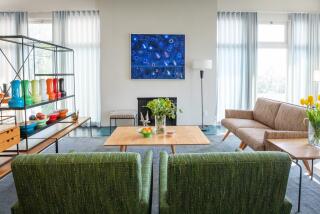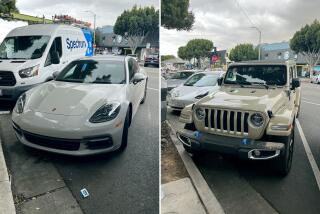It’s What’s Inside That Counts
- Share via
The automotive interior, once relegated to beginners in the styling center, is becoming the designer’s new frontier.
“Cars are getting more and more functional, and the exteriors aren’t making the personality and lifestyle statements they used to,” said Ken Okuyama, chairman of the transportation design department at the Art Center College of Design in Pasadena. “We are getting into a new phase in which the interior is becoming more important and the exterior more neutral.”
That might sound blasphemous, coming from a designer who worked on the forthcoming Ferrari FX and the current-generation Chevrolet Corvette. But those are specialty cars, Okuyama said, and there always will be a place in the world for niche models that make statements.
But in the mainstream auto market, he said, splashy exteriors come and go. The cycle has turned to cocooning, with auto buyers, especially in the fast-growing U.S. luxury market, more concerned about their immediate environments than the images their vehicles project to those looking at the outside.
Johnson Controls Inc., a major developer of automotive components and equipment, agrees with Okuyama’s thinking and recently unveiled a concept for a next-generation luxury vehicle. It is designed around the idea that people are spending more and more time in their vehicles and are seeking environments that can be adapted to work and leisure.
John Krsteski, who designed the Ariston Concept interior for Johnson Controls, said the project evolved from the company’s studies in Europe and North America of what buyers want in a luxury vehicle.
“We found that luxury isn’t just a statement that you can make by styling or by adding luxurious appointments like wood trim,” he said. “It is an experience, like going to a fine restaurant and having the maitre d’ present you with the menu. It starts as you get in, and it includes all your surroundings and instruments” just as tableware and upholstery fabrics help establish a luxurious restaurant.
In the Ariston study, that meant that the interior designers dictated certain exterior treatments, including doors that open wide and without obstruction to invite the driver and other occupants.
Owners of luxury vehicles place a premium on people space over luggage space, the Johnson Control team found, so the passenger cabin was lengthened, moving the back seat farther into what typically would be trunk space, to provide a more limousine-like roominess.
“And we found that people, even in the luxury market, also are moving to sport utility vehicles because they like the command seating and the sense of security, so we raised the roof line and the seat height,” said Krsteski, showing off the Ariston Concept at a recent one-day design event in Los Angeles.
The Johnson Controls interior study also demands a higher-than-usual belt line--the point along the side of a vehicle where sheet metal meets window glass--to provide more space in the doors for concealed storage and more depth in the interior to increase occupants’ sense of being cushioned.
Krsteski carried the restaurant analogy deeper into the car with an instrument panel that “serves” its devices on demand and stores them when not in use to present the appearance of a clean tabletop.
Thus, the steering wheel is a prototype that folds flat and slips into a concealed position inside the fabric-covered dashboard. The wheel emerges and locks into operating position with the touch of a button when the driver enters the car, and it stows away at the end of a trip “to announce that you are at the end of the journey,” Krsteski said.
The instrument panel itself pops up when the car is running and folds flat when the ignition is off.
The clean dash that occupants see at the start and finish of a trip “lets each journey become a fresh start,” the designer said.
Luxury also is about not being bothered by the things you don’t need, he said. So the Ariston design eliminates the visual clutter of dash-mounted air vents, hiding them under the dash.
The instrument panel uses digital readouts and lets the driver call up information as needed.
“You control this environment,” Krsteski said. “You are the captain. And the instruments surround the driver, so the passengers don’t have to be bothered or distracted.”
The concept considers passengers as individuals, so each seating position has its primary function.
One is a business center, with a desktop that pulls out from the back of the driver’s seat and a docking station that will accept telephones, fax machines and laptop computers.
Another is configured for relaxation, with padded armrests, a footrest, individual headsets for the audio system and a lounge-style seat.
Other touches include briefcase storage in the rear door panels and unobtrusive, touch-sensitive “smart” switches--for controlling windows, air conditioning, entertainment and other systems--that are woven into the armrest upholstery fabric.
Krsteski said that by designing the interior as a modular element that could be built separately by an outside vendor and installed in one piece on an auto maker’s assembly line, a variety of colors, fabrics, even seating materials and configurations, would be possible.
“Choice is what luxury is all about,” he said.






